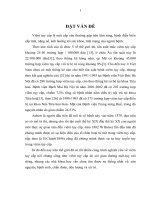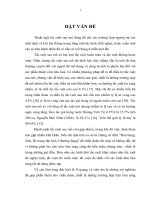ĐÁNH GIÁ HUYẾT ĐỘNG HỌC TRONG HỒI SỨC SỐC TRẺ EM.PGS.TS. PHẠM VĂN QUANG Bệnh Viện Nhi Đồng 1
Bạn đang xem bản rút gọn của tài liệu. Xem và tải ngay bản đầy đủ của tài liệu tại đây (6.44 MB, 83 trang )
CẬP NHẬT
ĐÁNH GIÁ HUYẾT ĐỘNG HỌC
TRONG HỒI SỨC SỐC TRẺ EM
PGS.TS. PHẠM VĂN QUANG
Bệnh Viện Nhi Đồng 1
ĐHYK Phạm Ngọc Thạch
NỘI DUNG
1.
ĐẠI CƯƠNG
2.
ĐÁNH GIÁ TIỀN TẢI
3.
ĐÁNH GIÁ HẬU TẢI & CO BÓP CƠ TIM
4.
ỨNG DỤNG MÁY ĐO CUNG LƯỢNG TIM
1. ĐẠI CƯƠNG
Định nghĩa: Sốc là tình trạng mà hệ thống tuần hồn khơng cung cấp
đủ oxy và dưỡng chất tới tổ chức.
Đánh giá huyết động học / bệnh nhân sốc:
▪
Tiền tải / đáp ứng bù dịch
▪
Hậu tải
▪
Co bóp cơ tim
▪
Cung lượng tim
Đánh giá tưới máu mô: Lactate, KMĐM, ScvO2
Hậu tải
Co bóp cơ tim
Tiền tải
Lượng máu bơm / một
nhịp
Nhịp tim
Cung lượng tim
Sức cản ngoại biên
(Davis et al, Crit Care Med; 2017)
1. ĐẠI CƯƠNG
Chiến lược điều trị sốc:
Đánh giá bệnh nhân có đáp ứng với bù dịch khơng ?
▪
Nếu có thì bù dịch
Đánh giá đủ dịch → Vận mạch, tăng co bóp cơ tim
1. ĐẠI CƯƠNG
Mục tiêu điều trị sốc:
Huyết động học ổn định:
▪
Chi ấm, mạch rõ bình thường theo tuổi, CRT <2 giây
▪
Huyết áp, MAP bình thường theo tuổi
▪
Áp lực tưới máu (MAP-CVP) bình thường theo tuổi
▪
Nước tiểu > 0,5 ml/kg/giờ
▪
3,3
Tưới máu mô tốt: Lactate < 2 mmol/L, không toan, ScvO2 > 70%
(Davis et al, Crit Care Med; 2017, 45(6): 1061-1093)
1. ĐẠI CƯƠNG
Ngưỡng tần số tim và áp lực tưới máu:
(Davis et al, Crit Care Med; 2017, 45(6): 1061-1093)
2. ĐÁNH GIÁ ĐÁP ỨNG BÙ DỊCH
Quan niệm trước đây:
Bệnh nhân có thiếu dịch, đủ dịch hay dư dịch ?
Quan niệm hiện nay:
Bệnh nhân có đáp ứng bù dịch khơng ?
Định nghĩa: Đáp ứng bù dịch khi thể tích nhát bóp (SV) hoặc cung
lượng tim (CO) tăng ≥ 10-15% sau khi được truyền nhanh 500ml dịch
(người lớn) # 10 ml/kg (trẻ em)
(Paul E. Marik (2016), Crit Care Med, Vol 44)
preload unresponsiveness
Stroke
Volume
preload responsiveness
Ventricular preload
CHEST 2002, 121:2000-8
Only 52% of patients responded
to fluid administration
in terms of CO increase
(JL Teboul, Conference on hemodynamic monitoring, 2018)
Fluid infusion
Hemodilution
↘ Hb
↘ DO2
• in fluid nonresponders CO =
• in fluid responders
↗ CO
↗ DO2
(JL Teboul, Conference on hemodynamic monitoring, 2018)
Fluid overload and mortality risk
3% mortality per 1% increase fluid overload
N=297 children
Multicentre
Sepsis 25%
37%
40%
FO in the PICU
FO occurs early in PICU
15 – 20% threshold
Fluid overload definition
FO differs
Mortality
associations
same
FO, balance-based definition most experience.
Use what you think is most accurate in YOUR PICU
normal heart
«
static
»
measures
of
preload
Stroke
preload responsiveness
volume
cannot
reliably
predict
failing heart
Assessing preload
fluid responsiveness
is not assessing
preload
responsiveness
preload unresponsiveness
.
Ventricular preload
Crit Care Med 2013; 41:1774-81
Summary AUC
1802 pts
0.56
(JL Teboul, Conference on hemodynamic monitoring, 2018)
ĐÁNH GIÁ CVP
Mục tiêu: đủ dịch CVP = 8-12 mmHg # 10-15 cmH2O
CVP < 10 cmH2O: truyền dịch
CVP 10-15 cmH2O + HĐH không ổn, nghi ngờ thiếu dịch
→
Test dịch và đánh giá sự thay đổi của CVP
→
CVP tăng ≥ 5 cmH2O: ngưng dịch
We recommend using
dynamic over static variables
to predict fluid responsiveness,
when applicable
We suggest that
dynamic over static variables be used
to predict fluid responsiveness,
when available
Dynamic indices of preload responsiveness
normal heart
preload responsiveness
Stroke
Heart-lung
volume interaction indices
Passive Leg Raising test
failing heart
preload unresponsiveness
Respiratory variation of SV
(PPV, SVV)
Ventricular preload
preload
unresponsiveness
Stroke
volume
preload
responsiveness
Ventricular preload
Am J Respir Crit Care Med 2000;
162:134-8
PPV =
PPmax
PPmax - PPmin
(PPmax + PPmin) /2
PPmin
(JL Teboul, Conference on hemodynamic monitoring, 2018)
Sensitivity
PPV
CVP
PAOP
1 - Specificity









